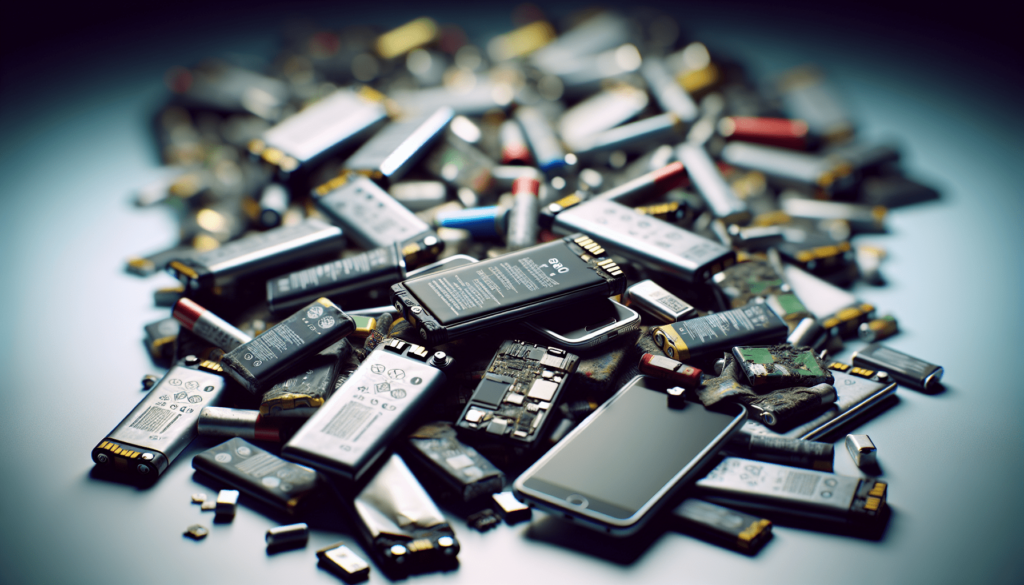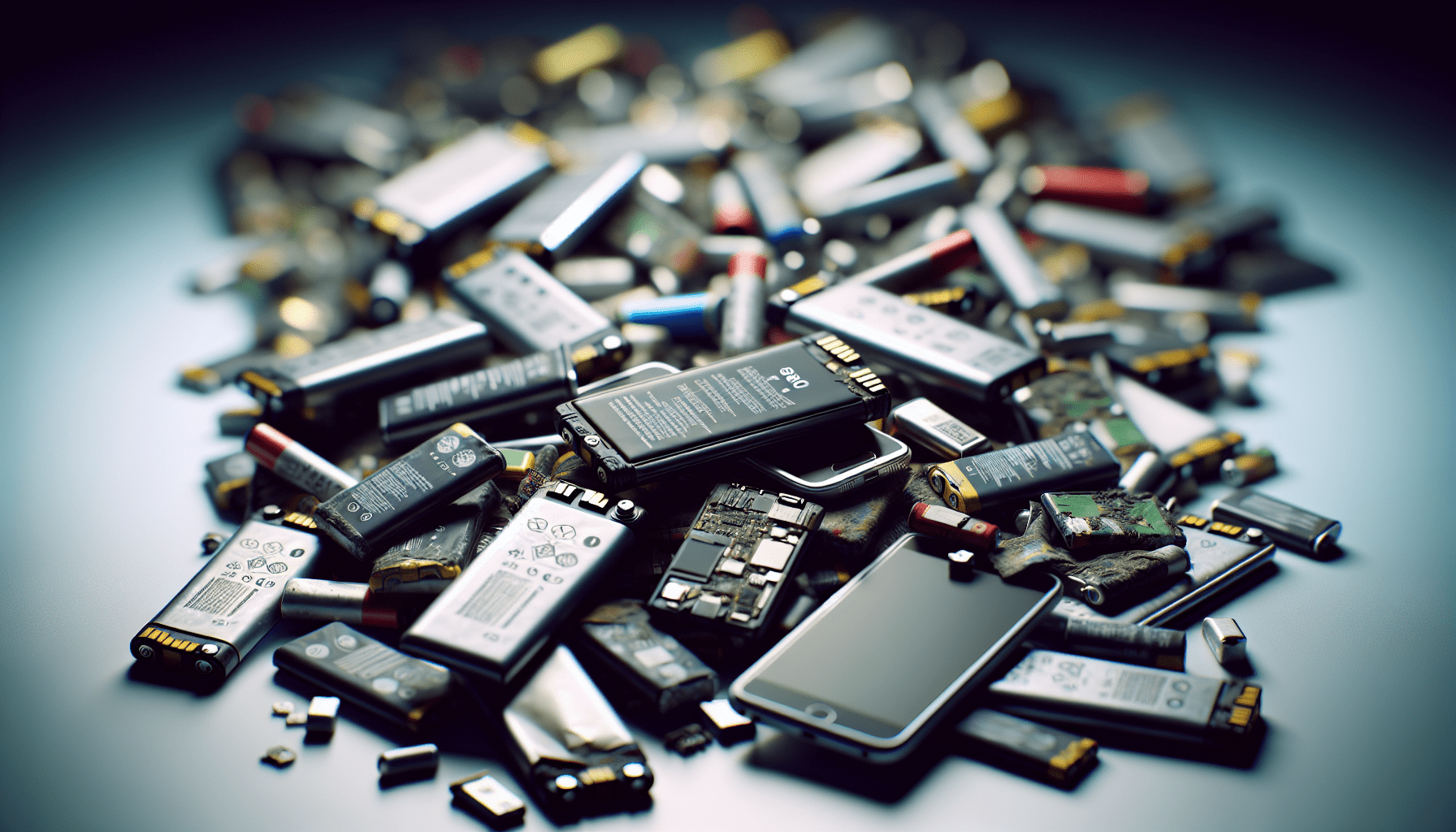Imagine a world without smartphones – it seems almost impossible, doesn’t it? Our lives have become so intertwined with these devices that we can hardly imagine a day without them. However, have you ever considered the impact that the production of these smartphones has on the environment? From the extraction of precious metals to the enormous amount of e-waste generated, the smartphone industry has a significant ecological footprint. In this article, we will explore the environmental consequences of smartphone production and delve into potential solutions to mitigate its impact. Let’s take a closer look at this fascinating topic together.

1. Extracting raw materials for smartphones
Environmental consequences of mining
Extracting raw materials for smartphones has significant environmental consequences, particularly due to the mining process involved. Mining activities often result in the destruction of natural landscapes, including forests and habitats of various species. These activities contribute to soil erosion, deforestation, and the loss of biodiversity in mining regions.
Depletion of natural resources
The extraction of raw materials for smartphones also leads to the depletion of natural resources. This includes the excessive consumption of minerals such as gold, silver, cobalt, and lithium, which are used in the production of various electronic components. Mining these resources contributes to their scarcity and raises concerns about their long-term availability.
Impacts on indigenous communities
Mining for smartphone materials can have detrimental impacts on indigenous communities. Many mining sites are located in areas inhabited by indigenous peoples, and their traditional lands and livelihoods are often threatened or destroyed due to mining activities. This leads to the displacement of communities, loss of cultural heritage, and social and economic challenges for indigenous peoples.
Air and water pollution
The mining process involved in extracting raw materials for smartphones also releases harmful pollutants into the air and water. Dust and emissions from mining machinery contribute to air pollution, while wastewater and chemical discharge from mining activities contaminate water sources. These pollutants not only harm human health but also damage ecosystems and disrupt aquatic life.
2. Manufacturing process of smartphones
Emissions of greenhouse gases
The manufacturing process of smartphones produces significant greenhouse gas emissions. This includes the emission of carbon dioxide (CO2) and other greenhouse gases from the energy-intensive production processes, transportation of materials, and operation of manufacturing facilities. These emissions contribute to climate change and its associated environmental impacts.
Energy consumption
The manufacturing of smartphones requires high amounts of energy, primarily derived from fossil fuels. This energy-intensive process contributes to the depletion of non-renewable energy sources and increases greenhouse gas emissions. Reducing energy consumption in the manufacturing process is crucial for mitigating environmental impact.
Generation of electronic waste
The production of smartphones also results in the generation of electronic waste. During the manufacturing process, defective or obsolete components are discarded, contributing to the growing problem of e-waste. These discarded materials often contain hazardous substances that pose risks to human health and the environment.
Worker exploitation
The manufacturing process of smartphones is often associated with worker exploitation. In some regions, workers endure long hours, unsafe working conditions, and low wages. Many workers lack job security, face exploitation by employers, and are denied their labor rights. Addressing these human rights issues is crucial for creating a sustainable and ethical smartphone manufacturing industry.
3. Deforestation for smartphone production
Clearing land for mining
Deforestation is a common consequence of smartphone production, particularly due to the need for mining operations. Forests are often cleared to make way for mining sites, leading to the loss of valuable ecosystems. Deforestation also results in soil degradation, increased carbon dioxide levels in the atmosphere, and the disruption of natural habitats.
Logging for paper production
Smartphone production involves the use of paper for packaging, user manuals, and other documentation. Logging for paper production contributes to deforestation and habitat destruction, putting additional pressure on already fragile ecosystems. Promoting sustainable sourcing and reducing paper consumption can help mitigate the impact on forests.
Loss of biodiversity
The deforestation and habitat destruction associated with smartphone production lead to the loss of biodiversity. Many species, including plants, animals, and insects, rely on forest ecosystems for survival. The destruction of their habitats threatens their existence and disrupts the delicate balance of natural ecosystems.
Disruption of ecosystems
The deforestation and alteration of landscapes for smartphone production disrupt ecosystems and ecological processes. This can have far-reaching consequences, such as the loss of pollinators, changes in water cycles, and the increased vulnerability of various species to extinction. Preserving ecosystems and their functions is vital for maintaining a healthy environment.
4. Water usage in smartphone manufacturing
Water-intensive processes
The manufacturing of smartphones involves numerous water-intensive processes, such as cooling, cleaning, and chemical reactions. These processes consume large amounts of water, putting pressure on local water sources. Ensuring efficient water management and minimizing water use is crucial for sustainable smartphone production.
Water pollution from chemical discharge
The use of chemicals in the manufacturing process can lead to the contamination of water sources. Discharge of wastewater containing toxic substances, such as heavy metals and solvents, can pollute rivers, lakes, and groundwater. This not only harms aquatic life but also poses risks to human health when contaminated water is used for drinking or irrigation.
Water scarcity in production regions
Smartphone production is often concentrated in regions experiencing water scarcity or facing water stress. The high water demand of the manufacturing process exacerbates water scarcity issues and can lead to conflicts between different water users. Implementing water conservation measures and incorporating water availability considerations into production decisions are essential for reducing the impact on water-stressed regions.
Impacts on local communities
The excessive water usage in smartphone manufacturing can negatively affect local communities. Depletion of water sources can lead to reduced access to clean drinking water, harm agricultural activities, and disrupt the livelihoods of communities that rely on water-based industries. Ensuring responsible water management practices and engaging with local communities is vital for minimizing these impacts.

5. Hazardous chemicals used in smartphone production
Toxic substances in electronic components
Smartphone production involves the use of various hazardous substances in electronic components. These components often contain toxic materials such as lead, mercury, arsenic, and brominated flame retardants. Improper handling or disposal of these substances can lead to environmental contamination and pose health risks to workers and communities.
Health risks for workers
Workers involved in smartphone production are exposed to hazardous chemicals and materials, putting their health at risk. Prolonged exposure to toxic substances can lead to respiratory problems, neurological disorders, and other serious health issues. Comprehensive occupational health and safety measures, including proper training and protective equipment, are necessary to protect workers.
Contamination of soil and water
Hazardous chemicals used in smartphone production can contaminate surrounding soil and water sources. Improper disposal or leakage of these chemicals can have long-lasting effects on ecosystems and potentially enter the food chain. Preventing contamination through responsible chemical handling and waste management is crucial for safeguarding the environment and human health.
E-waste management challenges
The disposal of smartphones and electronic waste (e-waste) presents significant challenges. Many electronic devices end up in landfill sites or are exported to developing countries with inadequate recycling facilities. This leads to e-waste accumulation and the release of toxic substances into the environment. Improving e-waste management systems and promoting responsible recycling are necessary for reducing the impact on the environment.
6. Electronic waste from smartphone disposal
Growing e-waste problem
The disposal of smartphones contributes to the growing global e-waste problem. As technology progresses and consumers replace devices more frequently, e-waste volumes increase exponentially. Improper disposal methods result in environmental contamination and the waste of valuable resources that could be recovered through recycling.
Toxicity of discarded smartphones
Discarded smartphones and other electronic devices contain hazardous substances, including lead, mercury, and brominated flame retardants. When thrown into landfills or processed through informal recycling methods, these toxic substances can contaminate soil, water, and the surrounding environment. Proper disposal and recycling of smartphones are essential to prevent further environmental pollution.
Challenges of recycling
Recycling smartphones and other electronic devices present several challenges. These include the complexity of extracting valuable materials, the lack of proper recycling infrastructure, and the high costs involved. Developing effective recycling methods and establishing e-waste collection and recycling facilities are necessary for addressing the e-waste problem.
Informal e-waste processing
In many regions, informal e-waste processing is common due to the lack of formal recycling channels. Informal recyclers often employ unsafe and environmentally damaging methods to extract valuable materials from discarded smartphones. This not only endangers the health of workers but also results in the release of toxic substances into the environment. Strengthening formal recycling systems and raising awareness about the hazards of informal processing are crucial steps towards responsible e-waste management.
7. Energy consumption and carbon footprint of smartphones
Energy-intensive production processes
The manufacturing process of smartphones requires significant amounts of energy, contributing to high carbon emissions. From the extraction of raw materials to the assembly of components, each step involves energy-intensive activities that heavily rely on fossil fuels. Transitioning towards more energy-efficient production methods and adopting renewable energy sources are vital for reducing the carbon footprint of smartphones.
Carbon emissions from manufacturing
The production of smartphones generates substantial carbon emissions due to the reliance on fossil fuel-based energy sources. These emissions contribute to climate change and its associated environmental impacts, such as global warming, sea-level rise, and extreme weather events. Increasing the use of renewable energy and implementing energy-saving measures are essential for decreasing carbon emissions.
Energy consumption during use
While the production process contributes to a smartphone’s carbon footprint, its energy consumption during use also plays a significant role. Powering the device, accessing the internet, and running applications require electricity, which often comes from conventional energy sources. Encouraging energy-efficient design, promoting user awareness about energy consumption, and utilizing renewable energy sources for charging can help minimize the energy impact of smartphones.
Charging infrastructure challenges
The increasing number of smartphones worldwide poses challenges for charging infrastructure. Traditional charging methods rely on electricity grids that may still rely on fossil fuels. Insufficient charging station availability and outdated infrastructure can hinder the adoption of renewable energy for charging smartphones. Expanding charging infrastructure, optimizing grid efficiency, and promoting the use of renewable energy for charging are necessary steps for reducing the environmental impact.
8. Human rights issues in smartphone supply chains
Exploitation of workers
The smartphone supply chains often involve exploitative labor practices, particularly in regions with low labor standards or weak enforcement of labor rights. Workers involved in the production of smartphones may face long working hours, low wages, and poor working conditions. Ensuring fair labor practices, upholding workers’ rights, and promoting transparency in supply chains are essential for ethical smartphone production.
Child labor in mining
Mining activities for raw materials used in smartphones have been linked to child labor in some regions. Children are often engaged in hazardous and physically demanding work, putting their wellbeing and development at risk. Strict adherence to regulations and continuous monitoring of supply chains are necessary to eliminate child labor from smartphone production.
Unsafe working conditions
The manufacturing process of smartphones can involve hazardous working environments where workers are exposed to toxic chemicals, excessive heat, or physical injuries due to poor safety standards. Establishing and enforcing robust occupational health and safety regulations, providing training and protective equipment, and promoting a safe work culture are crucial for safeguarding workers’ wellbeing.
Violation of labor rights
The production of smartphones sometimes involves the violation of labor rights, including the freedom of association and collective bargaining. Workers may face restrictions in forming unions or voicing their concerns, preventing them from exercising their rights. Upholding labor rights, promoting fair wage policies, and ensuring workers’ representation in decision-making processes are essential for a socially responsible smartphone supply chain.
9. Green initiatives in smartphone manufacturing
Recycling and e-waste management programs
Many smartphone manufacturers have begun implementing recycling and e-waste management programs to mitigate the environmental impact of smartphone disposal. These programs help recover valuable materials from discarded devices, reduce the need for raw material extraction, and promote responsible e-waste management practices.
Renewable energy initiatives
Some smartphone manufacturers are transitioning towards renewable energy sources to power their production facilities and charging infrastructure. Installing solar panels, using wind energy, or purchasing renewable energy certificates help to reduce the carbon footprint and promote the shift towards a sustainable energy future.
Reduction of carbon emissions
Smartphone manufacturers are increasingly focusing on reducing carbon emissions throughout the product lifecycle. From optimizing manufacturing processes to improving energy efficiency during use, various strategies are being implemented to minimize carbon emissions. Setting ambitious emission reduction targets and embracing innovative technologies are crucial for achieving sustainable production.
Sustainable sourcing of raw materials
Ethical sourcing of raw materials is gaining prominence in smartphone manufacturing. Sustainable sourcing practices aim to minimize the ecological and social impact of extracting materials by avoiding conflict minerals, engaging in responsible mining practices, and supporting local communities. Ensuring transparency and accountability throughout the supply chain is essential for sustainable sourcing.
10. Consumer responsibility and sustainable choices
Extended product lifecycles
As consumers, extending the lifecycle of smartphones is an effective way to reduce the environmental impact. Choosing durable devices, properly maintaining them, and considering repair options instead of immediate replacement can help reduce resource consumption and e-waste generation.
Repair and reuse initiatives
Promoting repair and reuse initiatives can significantly contribute to reducing the environmental impact of smartphone production. Repairing damaged smartphones rather than replacing them, and opting for refurbished devices, not only saves money but also extends the lifespan of electronic devices and reduces waste generation.
Support for ethical phone brands
Supporting ethical phone brands that prioritize environmental sustainability and social responsibility is an important consumer choice. By purchasing smartphones from companies with transparent and ethical supply chains, consumers can encourage responsible production practices and contribute to a more sustainable industry.
Demand for eco-friendly features
As consumers become more conscious of environmental issues, there is an increasing demand for smartphones with eco-friendly features. Manufacturers are responding by designing energy-efficient devices, using recyclable materials, and reducing packaging waste. By prioritizing and demanding eco-friendly features, consumers can drive the industry towards sustainable practices.
In conclusion, smartphone production has significant environmental impacts across various stages, from raw material extraction to disposal. The extraction of raw materials leads to environmental consequences, depletion of natural resources, and impacts on indigenous communities. The manufacturing process contributes to greenhouse gas emissions, energy consumption, and the generation of electronic waste. Deforestation, water usage, hazardous chemicals, and human rights issues are also prevalent in smartphone production. However, efforts are being made towards green initiatives, such as recycling and e-waste management programs, renewable energy initiatives, reduction of carbon emissions, and sustainable sourcing of raw materials. Consumer responsibility and sustainable choices, including extended product lifecycles, repair and reuse initiatives, support for ethical phone brands, and demand for eco-friendly features, can also contribute to reducing the environmental impact of smartphones. With collective efforts, the negative environmental and social consequences of smartphone production can be mitigated, leading to a more sustainable and responsible industry.

